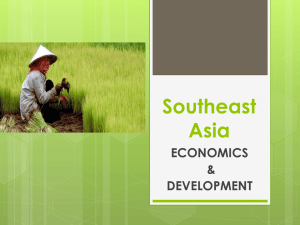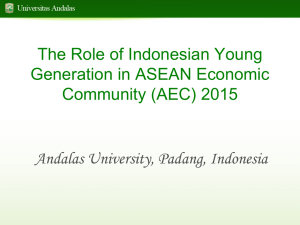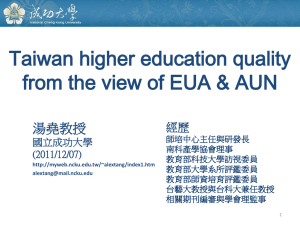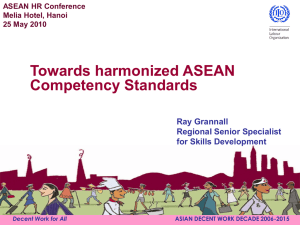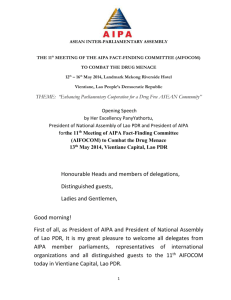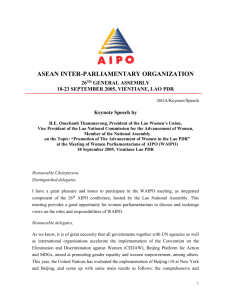Labour and Social Trends in ASEAN 2010: Sustaining
advertisement
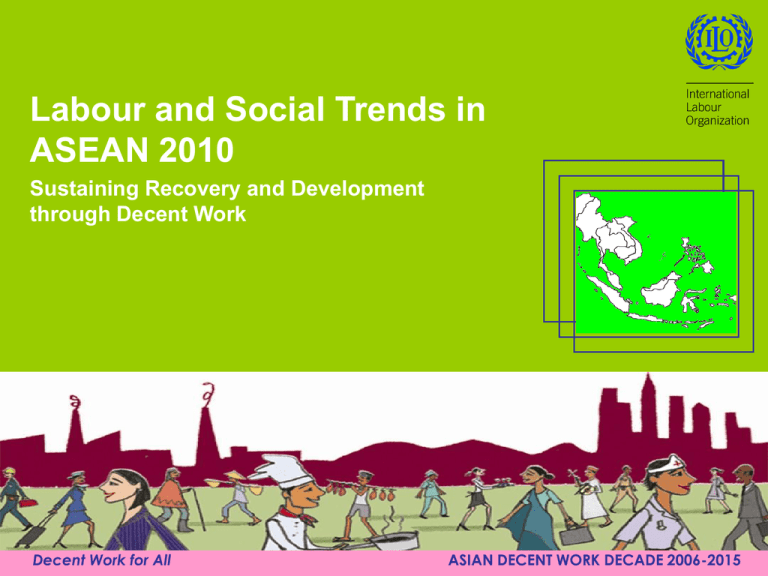
Labour and Social Trends in ASEAN 2010 Sustaining Recovery and Development through Decent Work Decent Work for All ASIAN DECENT WORK DECADE 2006-2015 Introduction Economic recovery and the challenge of re-balancing growth Labour market recovery and the challenge of creating more and better jobs Labour productivity and the challenge of increasing competitiveness and ensuring prosperity for all Human resources and the challenge of meeting the skills needs for sustainable and balanced growth Conclusions and recommendations Economic recovery: V-shaped for some, more gradual for others Quarterly GDP growth, y-o-y (%) Sources: ASEAN Finance and Macro-economic Surveillance Unit Database; national statistical offices. …supported by massive fiscal stimulus measures Key challenge ahead: Achieve strong, sustainable and balanced growth Gradual transition to private-sector led growth Deeper regional integration Stronger domestic demand (investment and consumption) Preparing for green growth and green jobs “We recognize the need to support more balanced growth within and across economies, achieve greater inclusiveness in our societies, sustain our environment, and raise our growth potential through good governance, innovation and a knowledge-based economy.” ASEAN Leaders’ Statement on Sustained Recovery and Development (Ha Noi, 9 April 2010) Growth in jobs and incomes is key to sustainable recovery and balanced development Investing in quality education and skills equally critical Labour market recovery: Unemployment has stabilized Unemployment rate (%) Sources: ILO Department of Statistics; national statistical offices. …but manufacturing continues to shed jobs Decline in employment in industry and rise in services Share of employment in industry and services (%) Industry 30 Services 65 60 25 55 20 50 45 15 40 10 35 2008 Q2 2008 Q4 Philippines 2009 Q2 Thailand 2009 Q4 Malaysia 2008 Q2 2009 Q2 2008 Q4 Philippines Thailand Malaysia 2009 Q4 Sources: ILO calculations based CEIC Data Company data drawn from national statistical sources. … but shift may entail movement of workers from relatively high value-added (and higher-paid) to lower value-added (and lower-paid) work A daunting but critical challenge: Creating more and better jobs The number of working poor (US$2 per day) has risen in the past two years, from 140 million to 158 million (or from 51% to 57% of ASEAN’s workers) Over 60% of ASEAN’s workers are estimated as “vulnerable”, working in the informal economy with little or no social protection in times of ill health, family emergency and financial uncertainty Building a “social floor” is crucial Ensure people’s security and a sense of community Reduce the adjustment costs of changing economy Improve market efficiency Productivity challenge in ASEAN Output per worker (constant 2009 US$) Source: Conference Board and Groningen Growth and Development Centre Total Economy Database, January 2010. Between 2007-2009, average annual labour productivity contracted by 0.3% in ASEAN but surged by 8.7% in China and 4.0% in India Large intra-regional disparity in productivity Output per worker, 2008 (constant 2009 US$) Singapore Malaysia Thailand ASEAN Philippines Indonesia Viet Nam Cambodia 0 10,000 20,000 30,000 40,000 50,000 60,000 70,000 80,000 90,000 Source: Conference Board and Groningen Growth and Development Centre Total Economy Database, January 2010. Essential that productivity gains lead to higher wages & better working conditions Productivity and real wages, average annual growth, 2001-2007 (%) 14 12 Productivity Wages 10 8 6 4 2 0 Indonesia Singapore Thailand China India Sources: ILO: Global Wage Report 2008/09; Conference Board and Groningen Growth and Development Centre Total Economy Database, January 2010. Higher wages support increased domestic consumption and less reliance on exports. Sharing gains can improve wages and working conditions, living standards and competitiveness Infrastructure development and SME support remain priorities in post-crisis Global competitiveness and infrastructure ranking, 2009/10 Source: World Economic Forum, Global Competitiveness Index Analyzer 2009-2010. Infrastructure development boosts employment, reduces inequality and expands demand Support to SMEs, which account for the bulk of ASEAN employment, is also critical Changing drivers of productivity growth Employment shift from agriculture to industry and services driving productivity growth in some countries In Cambodia 47%, in Viet Nam 37%, in Lao PDR 24% (2000-2006) Growing focus on efficiency, innovation and creativity Increased priority of environment-friendly productivity growth Skills and knowledge, working conditions and progressive HR practices, based on rights at work and social dialogue, are increasingly important drivers Post-crisis priority shifts to workforce and job quality Finance Minister, Singapore: “… our priority during last year’s global crisis was to keep jobs. Our priority must now be to improve the quality of jobs.” (Budget speech, 2010) Prime Minister, Malaysia: “As we emerge from a global recession,… we have to give our children the best education… and build a highlyskilled workforce. We must increase productivity, stimulate innovation and enhance the skills of the Malaysian workforce.” (May 2010) Ongoing reform in many ASEAN Member Countries Lao PDR: National education system reform Indonesia: Vocational training system reform Part of a global trend: G-20 leaders pledged “to support robust training efforts in [their] growth strategies and investments” in the context of a “framework for strong, sustainable and balanced growth.” (Pittsburgh, Sep 2009) Skills could bring multiple benefits Greater capacity of persons to adjust to structural change and take advantage of new opportunities More productive and higher performing enterprises Higher levels of economic output and living standards Skills development bears heavily on employment and workplace productivity, the main determinants of future prosperity Challenges to training and skills development Labour force growth in ASEAN + 3 and India, 2010-2010 (%) Lao PDR Cambodia Philippines Brunei Malaysia Indonesia Myanmar Viet Nam Singapore Thailand ASEAN India Korea, Republic of China Japan -10 -5 0 5 10 15 20 25 30 Source: ILO, LABORSTA, Economically Active Population Estimates and Projections (5th Edition). Demographic change: expanding labour force but some ageing fast Challenges to training and skills development (cont.) Rising female labour force participation in some countries Massive sectoral change Technology and innovation Deepening regional integration Increasing migration flows Climate change and transition to a green economy Different stages of development, different challenges in education Gross enrolment rate, most recent year (%) Japan Korea, Rep. of Brunei Darussalam Philippines Indonesia China Malaysia India Myanmar Lao PDR Secondary Cambodia Korea, Rep. of 0 20 40 60 80 100 Japan Malaysia China Indonesia Brunei Darussalam India Lao PDR Myanmar Tertiary Cambodia 0 20 Source: UNESCO Institute for Statistics. 40 60 80 100 Conclusions and recommendations Meet the needs of today and anticipate the future Produce quality LMI for informed decisions (LFS) Make employment, career and training services broadly available Better anticipate future requirements and skills needed Focus on core skills, learning ability and smooth pathways to learning Expand skills recognition and portability to improve migration management Encourage partnership between policy-makers, business community, education sector and workers’ representatives Share the costs for financing skills development Integrate skills development with economic, social and employment policies Promote gender equality and equal access and ensure inclusiveness ASIAN DECENT WORK DECADE 2006-2015 Decent Work for All Thank you Gyorgy Sziraczki Senior Economist ILO Asia-Pacific Regional Office sziraczki@ilo.org

